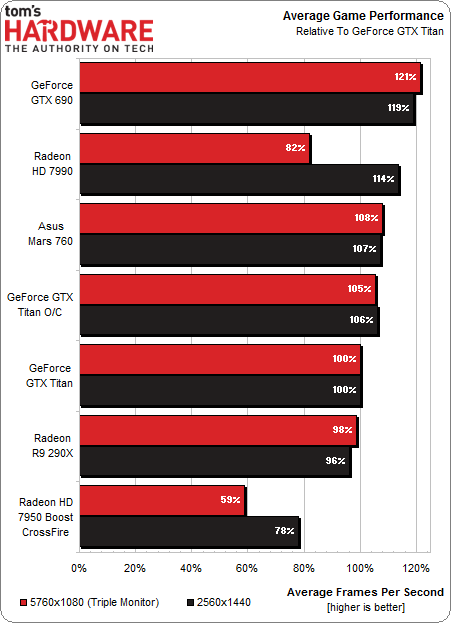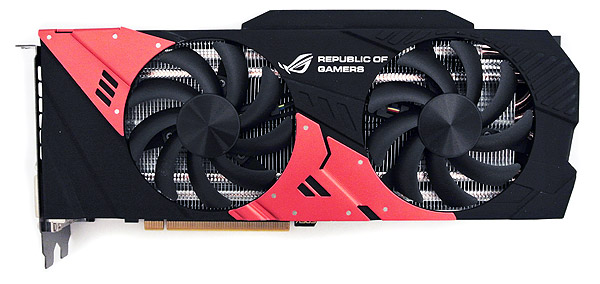Asus Mars 760 Review: Two GPUs In SLI; One $650 Graphics Card
We like the idea of two GK104 GPUs in SLI on one graphics card. Sounds like a GeForce GTX 690, right? Except that board costs $1000 and Asus' Mars 760 sells for $650. In a world with sub-$700 GeForce GTX 780 Tis, can this dual-GPU stunner still impress?
Asus Mars 760: We Dig The Innovation, But There Are Smarter High-End Buys
Before we start drawing conclusions, let's look at the combined average performance across all of our benchmarks. The results are relative to Nvidia's GeForce GTX Titan at 100%. That black bar represents frame rates at 2560x1440, while the red bar is indicative of 5760x1080 using three monitors.
The chart's most glaring red flag is that AMD's frame pacing feature is not yet working in dual-GPU setups across multiple monitors. That's a long-standing issue, and it should be cleared up soon. AMD says its Catalyst 14.1 driver includes this functionality, though it'll be a beta release when it does finally emerge (Ed.: Not that proper frame pacing is going to change my opinion of the Radeon HD 7990...).
How about the Mars 760 against Nvidia's GeForce GTX Titan? Asus says the Mars board should be 7% faster, and the average at 2560x1440 across the games we tested lands right at 7%. It's easy to see why Asus' marketing team would want to draw its comparison to Nvidia's premium flagship. The Mars certainly looks like a stellar value next to that $1000 beast. No doubt this comparison helped spawn the creation of the Mars 760.
Times have changed since this thing was conceptualized, though. First, there's the Radeon R9 290X, which started at $550 and forced Nvidia to cut the price of its GeForce GTX 780. The Radeon might be closer to $630 now, but the impressive GeForce GTX 780 Ti is down from its $750 launch price, closer to $680. The overclocked GeForce GTX Titan benchmarks give us an approximate idea of the 780 Ti's performance, which is right on par with Asus' Mars 760.
Selling for $650 and able to keep up with a GeForce GTX 780 Ti, Asus' Mars 760 seems like a reasonable value next to some of Nvidia's heavy hitters. But there are other factors that tug us away from a dual-GPU solution, such as higher frame time latencies and a practical limit of 2 GB per GPU. Although Nvidia's SLI-based configurations perform notably better than CrossFire, single-GPU cards like the GeForce GTX 780 Ti retain an advantage (not to mention an extra gigabyte of GDDR5). But an even bigger value challenge comes simply from two GeForce GTX 760 cards in SLI, which sell for $500. So long as you have enough space on your motherboard and headroom from your power supply, that's probably a smarter choice.
Who might disregard those caveats and go with the Mars 760 anyway? Enthusiasts without room on their motherboards for two dual-slot boards, to start. Chassis dimensions come into play as well. Additionally, tuners will appreciate the Mars' willingness to exceed Asus' factory-set frequencies on the road to GeForce GTX 690-like performance (though we can't guarantee retail samples will scale as well as our press card). Finally, fans of Asus' one-off creations may find the style and exclusivity of this limited-production Mars 760 appealing.
No doubt, a $650 Mars 760 would have been a hotter-ticket item before Nvidia cut the price tag on its GeForce GTX 780 to make room for the 780 Ti. But with Nvidia's fastest single-GPU offering under $700 now, that card steals some of Asus' thunder. Today, it'd be easier to make a value case for the Mars somewhere under $600. This is clearly a special piece of equipment though, and it's fast enough that we doubt it'll last very long on Newegg. Even if it isn't the most attractively-priced graphics card, enthusiasts appreciate unique, and the Mars 760 does effectively integrate two very quick GK104 GPUs on a single PCB. Up until now, only Nvidia's reference-class $1000 GeForce GTX 690s did this.
Get Tom's Hardware's best news and in-depth reviews, straight to your inbox.
Current page: Asus Mars 760: We Dig The Innovation, But There Are Smarter High-End Buys
Prev Page Power, Temperature, And Noise BenchmarksDon Woligroski was a former senior hardware editor for Tom's Hardware. He has covered a wide range of PC hardware topics, including CPUs, GPUs, system building, and emerging technologies.

